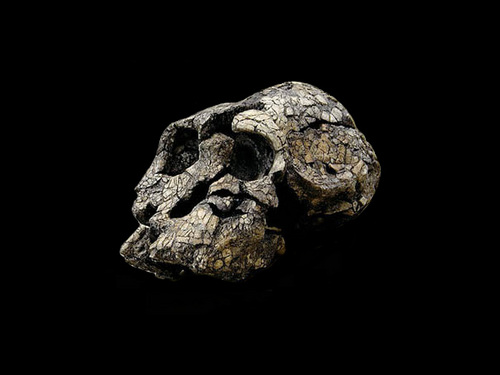일반명 : 케냔트로푸스 플라티옵스
학 명 : Kenyanthropus platyops(KNM-WT-40000)
시 대 : 3.5 MYA.
발견지역 : west of Lake Turkana, Kenya
발견시기 : 1999
발견자 : J. Erus, a member of Meave Leakey's team
발 표 : In 2001 Leakey, et al. described the specimen in Nature.
3.5 MYA. The Kenyanthropus platyops Skull KNM-WT-40000 was discovered in 1999 by J. Erus, a member of Meave Leakey's team, west of
National Geographic Society
New Face Added to Humankind's Family Tree
For full coverage of this story watch National Geographic Today Wednesday, March 21, in the
Lisa Krause National Geographic News (March 21, 2001)
On the western
The find suggests that eastern
From Wikipedia
Kenyanthropus platyops is a 3.5 to 3.2 million year old (Pliocene) extinct hominin species that was discovered in Lake Turkana, Kenya in 1999 by Justus Erus, who was part of Meave Leakey's team. [1] The fossil found features a broad flat face with a toe bone that suggests it probably walked upright. Teeth are intermediate between typical human and typical ape forms. Kenyanthropus platyops, which means "Flat faced man of
The bones discovered at the site included more than 30 skull and tooth fragments in a stratum dated to between 3.5 and 3.2 million years ago. The fossil was named the Flat Faced Man of Kenya, or Kenyanthropus platyops, by Dr. Meave Leakey, of the National Museums of
Dr. Leakey believes that it belongs to a entirely new genus of ancestors, and is the oldest "reasonably complete" cranium found so far. Humans were once thought to have evolved from only one member of Australopithecus afarensis, the species made famous by the fossil Lucy. But now it seems Lucy may have been sharing the woods and grass plains of prehistoric Africa with a rival.
Until more recent discoveries were made, it seemed as if the evolution of man might be “special” since there appeared to be only one single line of hominids leading from the most primitive to Modern Man of today. And since evolution normally proceeds in branches, multiplying as each branch divides, hominid evolution seemed for a while to be the one exception. Now, with the discovery of Kenyanthopus, the picture looks more “normal”.
At present anthropologists aren’t sure how many branches there might have been 3 million years ago. Branches may have gone extinct that we haven’t yet found representatives for; but such fossils could be discovered at any time.
When learning of the discovery, Dr. Daniel Lieberman, an anthropologist at
The Kenyanthropus fossil has a small earhole, like those of chimpanzees. It also shares many features of other primitive hominids, such as a small brain, but it also has striking differences, including high cheek bones, and a flat plane beneath its nose bone, which gives it a flat face.
"It shows that our past is like that of any other mammal," said Meave Leakey, head of the paleontology department of the National Museums of
According to Leakey and the authors of the report, which appears in the March 22 issue of Nature, the fossil find points to diet-driven adaptation, in which species of hominin evolved to take advantage of different food sources.
Two Distinct Species
The skull of Kenyanthropus platyops was discovered in 1999 by Justus Erus, a team member. The expedition was searching the 3.2 to 3.5 million-year-old sediments of the
Since the skull discovery, team member Christopher Kiarie has been conducting meticulous work to establish the genus and species of the skull, which is characterized by small molar teeth, and a tall flat face.
"Platyops means 'flat face,'" said Leakey.
This physical description is vastly different from that of Australopithicus afarensis, said Leakey. Lucy and her kin had protruding faces and large teeth.
"The shape of the face clearly differentiates it from Australopithicus afarensis and species that lived later," said Leakey.
According to the scientists, both tooth size and shape are indicators of diet and the way in which a species chews its food.
"The architecture of the face really depends on the diet and how its jaws are working," said Leakey. "This is significant because it means these ancestors were inhabiting a different ecological niche."
Both Kenyanthropus platyops and Australopithicus afarensis could have existed side by side without direct competition for food resources, says Leakey.
Before the discovery of Kenyanthropus platyops, most scientists believed that hominins did not develop a flat face until approximately two million years ago.
Changing Picture of Evolution
Though the discovery seems to blur the lines of humankind's family tree, according to Daniel Lieberman, an anthropologist at
Since the 1970s, anthropologists have been uncovering evidence that modern humans did not follow a linear evolution in which one species evolved from the previous species. The finds suggest that instead, numerous species existed, and each adapted to different environments.
Multiple species of hominin had been discovered from time periods earlier and later than Lucy and her kin, but the fossil record showed only one ancestor for the middle Pleiocene, approximately 3.5 million years ago, says Lieberman.
"[Finding Kenyanthropus platyops] was what I expected," said Leakey. "If you look at the evolution of any other mammal, there's usually a radiation of species and just a few species survive. It didn't seem right that there was only one line of evolution [for this time period]. There should have been other species around."
Kenyanthropus platyops helps to fill in the picture of this period of evolution, said Lieberman. It indicates that multiple, different-looking species coexisted and filled different ecological niches.
"We had a long and complex past," said Leakey. "And we are the single surviving species. Our existence is not secure. Just like everything else, we can be extinct too."









































 수량을 선택해주세요.
수량을 선택해주세요.





































